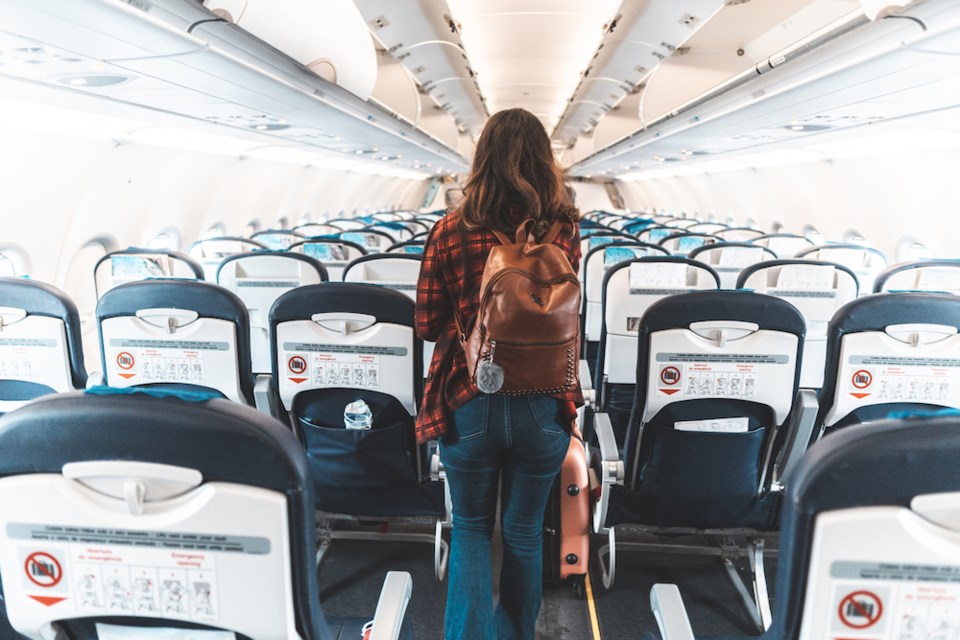The British Columbia Centre for Disease Control (BCCDC) on Friday evening added 14 more Vancouver flights to its list of COVID-19 public exposures.
The public health agency on Nov. 13 warned passengers who travelled aboard the following flights that they may have recently been exposed to the virus responsible for the ongoing global pandemic.
- Oct 31, Air Canada 855, London to Vancouver (Affected rows 40-46)
- Nov 2, WestJet 183, Calgary to Kelowna (Affected rows 2-8)
- Nov 4, Air Canada 45, Delhi to Vancouver (Affected rows 21-17 )
- Nov 5, Flair 8186, Winnipeg to Kelowna (Affected rows 18-24)
- Nov 5, Swoop 118, Abbotsford to Hamilton (Affected rows not reported)
- Nov 7, Air Canada 1055, Phoenix to Vancouver (Affected rows 19-25)
- Nov 8, WestJet 133, Calgary to Vancouver (Affected rows 22-28)
- Nov 8, Air Canada 221, Calgary to Vancouver (Affected rows 16-22 )
- Nov 9, Air Canada 44, Vancouver to Delhi (Affected rows 34-30)
- Nov 9, Air Canada 241, Edmonton to Vancouver (Affected rows 23-29)
- Nov 9, Air Canada 311, Montreal to Vancouver (Affected rows 29-35)
- Nov 9, Air Canada/Sky Regional 7724, Houston to Vancouver (Affected rows 4 & 12-16)
- Nov 9, Flair 8102, Calgary to Vancouver (Affected rows 13-19)
- Nov 9, Lufthansa 492, Frankfurt to Vancouver (Affected rows 31-37)
This most recent update comes following numerous B.C. flights identified this week for potentially exposing passengers to the virus, including a total of 21 Vancouver flights that Vancouver Is Awesome reported throughout the day Thursday.
The BCCDC is encouraging travellers who recently returned to B.C. to check the public health agency's website for updates about flights identified for the risk of exposure. Passengers who flew aboard on a domestic flight flagged for carrying a COVID-19 case are in turn encouraged to self-monitor for symptoms for 14 days following their flight.
Any passengers who have travelled outside of Canada, meanwhile, are required to self-isolate and self-monitor for symptoms for 14 days upon their arrival. The government continues to discourage Canadians from any non-essential travel outside Canada at this time. It's implemented a global travel advisory that states, "This advisory overrides other risk levels on this page, with the exception of any risk levels for countries or regions where we advise to avoid all travel."
Any returning travellers who develop symptoms following their arrival in Canada should get tested for COVID-19. Individuals who test positive are required to self-isolate for a minimum of 14 days from their arrival date, or 10 days after onset of symptoms, whichever is longer.
While self-monitoring for symptoms of the virus— which may include fever, cough, chills, sore throat, loss of sense of smell or taste and many more—individuals should take and record their temperature daily, and avoid taking fever-reducing medications like acetaminophen or ibuprofen if possible, for 14 days following their return to Canada or last known exposure to a confirmed COVID-19 case. The average normal body temperature taken orally is about 37°C, according to the BCCDC.
For more information about self-monitoring and self-isolation, head to the BCCDC's website.
- With files from Elana Shepert
The latest Vancouver flights to land a spot on the BCCDC's ever-growing public exposures list include a flight to Edmonton and another from Toronto.
Posted by Vancouver Is Awesome on Friday, November 13, 2020



